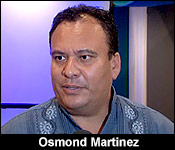 A census should be conducted every ten years - that's the global standard. For Belize - that should have been in 2020, but then, COVID happened. So the census had to be pushed back and the millions earmarked for it - had to be used in the COVID response effort.
A census should be conducted every ten years - that's the global standard. For Belize - that should have been in 2020, but then, COVID happened. So the census had to be pushed back and the millions earmarked for it - had to be used in the COVID response effort.
So the census was delayed and didn't start until May of 2022 and it continued until January of 2023.
The findings and the rich trove of data were presented today at the Biltmore and the numbers illustrate a changing Belize - with a smaller population than projected. Jules Vasquez reports:
Diana Castillo - Trejo, Director General - SIB
 "As of 2010, our national household population stood at 322,424. In 2022, our total population count was 397,483."
"As of 2010, our national household population stood at 322,424. In 2022, our total population count was 397,483."
But estimates had the population at 441 thousand. So what happened? Census says,…fertility rates are declining:
Diana Castillo - Trejo, Director General - SIB
"Our population has been growing at a slower rate than was previously estimated. We also see that the rate of growth for our population has been decelerating. We grow by less and less every year. And this is due in large part to declining fertility rate."
And Belize' s population is also aging - shown by this pyramid shrinking at the bottom:
Diana Castillo - Trejo, Director General - SIB
"At least the beginning of a gradual aging of our population. Remember, fertility rates are declining. People are having less children."
"Base of our population is shrinking. And we are starting to age as a population over time. The national median age increased from 21 in 2010 to 25 years in 2022. Again, signaling that our population is starting to gradually age."
And the much talked about man shortage - isn't just the stuff of folklore, it showing itself in a demographic shift where 40 years of independence there are - percentage wise - fewer men:
Diana Castillo - Trejo, Director General - SIB
"So if we look back 40 years ago to 1980, the situation was actually exactly reversed. There were slightly more males than females, a little bit over 50% of the population was comprised of males and around 49 something percent was made of females."
"Over a decade from one round of the census to the next, what we saw was gradual evening out until 2010 when we were at virtually 50-50, the number of males, the number of females was virtually even, and in 2022 the trend continued in that direction where the number of females slightly overtook the number of males."
In terms of ethnicity - the long declining creole population showed the strongest growth of any single ethnic group. - but it is. still a distant second to mestizo's:
Diana Castillo - Trejo, Director General - SIB
"Roughly around half of our population self-identified as being mestizo, hispanic, or latino."
"Roughly a quarter identified as being creole. Mayas comprised just under 10% and the Garifuna population about 4%, and between these four major ethnic groups they accounted for more than 90% of our entire population."
And that population speaks more English than before:
Diana Castillo - Trejo, Director General - SIB
"Three-quarters of the population indicated that they speak English fluently and this was up from just under two-thirds in 2010. More than a half indicated that they speak Spanish fluently, which is slightly down from 2010, and just about a half indicated that they speak Creole fluently."
One of the most telling indicators of social change is the fact that almost a third of the population claims no religious affiliation - double the number 12 years earlier:
Diana Castillo - Trejo, Director General - SIB
"We can see that between 2010 and 2022 there has been a gradual shift away from affiliation to organized religion."
"With respect to religious affiliation, the biggest growth that we have seen is among persons who have no religious affiliation. Persons who identify with no organized religion doubled from just over 15% in 2010 to over 30%, 31% in 2022."
And, perhaps consistent with that, there are fewer persons in married unions.
Diana Castillo - Trejo, Director General - SIB
"There is a shift, a slight shift away from being married, living with a spouse, to common law, living arrangements. So there's a decrease in both males and females in the percent of the population that reported that they were married and currently living with their spouse and that corresponded with an increase in the number or the percent of persons who reported that they lived in a common law union."
These many data points will now be taken and used to shape national policies:
 Joseph Waight, Financial Secretary
Joseph Waight, Financial Secretary
"Information from the census will be used to develop policies and programs to further build upon these already significant successes and to better target them in those areas and populations where they can have the greatest impact."
Osmond Martinez, CEO - Ministry of Economic Development
"This data will allow us not to only objectively measure the progress that our country has made over the past decade or the past three years, but also to identify where government needs to place its focus and direct it resources going forward."
One area is housing in the Toledo District which showed the largest household sizes:
 Osmond Martinez, CEO - Ministry of Economic Development
Osmond Martinez, CEO - Ministry of Economic Development
"Well I'm really concerned about the high population per house or persons per house in the Toledo District which has the highest. When you look at the Toledo District it has the the highest in all the negative indicators and that's of high concern but my second one which is a little bit very interested and even it can be a little bit funny depends on how the audience look at it but fertility you know whereby our population is decreasing and Stan Creek district was the only one whose population is actually increasing, but note that we have received the data the most important thing is to note that this is not the end but it's the beginning."
And also the beginning of our story, There is - as they say - a lot to unpack - and tomorrow we'll present part two of the census findings with the "Household Characteristics".



